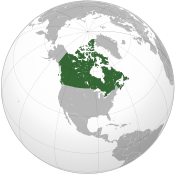73M-year-old fossilized fish found in Canada
Thursday, August 28, 2008

Image: SimonP in January 2005.
Scientists of the United Kingdom-based Royal Society released a paper August 1, 2008 which studied Cretaceous era fossil finds found at the northern area of Devon Island in the 1980s. Nunavutospongia irregulara is the name of the new species of sponge found, released by Proceedings B the Royal Society's biological research journal.
Thick bones and armour-like scales have been found that are believed to belong to a new species of fish which grew up to two meters long. Thousands of fossilized feces - termed coprolites - both small and as large as an arm have been found. Coral reef fossils, conifer wood debris, fossil wood chunks and thousands of plankton and microbes have been found both at Devon Island and Beechy Island. Beechy Island is connected to Devon Island during times of low tide.
Two areas on Devon Island about 30 kilometres apart are providing Cretaceous fossil finds, and each is kilometres in length. These areas are khaki-coloured valley greensands rich in fossil beds, which provide a peek at life 73 million years ago. During the Cretaceous Devon Island was located in a position with a warmer climate, large trees grew north of Baffin Island, and plesiosaurs, ichthyodectid fish, and sharks roamed the waters of the Arctic. Devon Island was submerged under warm water in the Cretaceous period, when the island was situated hundreds of kilometres south of its current location due to continental drift.
At the upper Kanguk Formation, the fossil finds represent offshore and near-shore sedimentary deposits on an ocean floor. The warmer temperate waters supported benthic invertebrates (organisms such as larva that live on the bottom of a water body) and large predatory vertebrates. Whereas life is currently supported by nutrients from the sea ice, Cretaceous sea life was supported by terrigenous resources from forested landscapes.
The eight-member team from the Royal Society consists of Canadian, United States and Polish researchers. The fossil specimens are held at the Canadian Museum of Nature in Ottawa on behalf of the Nunavut territorial government.
Sources
- Randy Boswell. "Arctic fossil ield yields sea serpents, shark teeth" — Canadian Broadcasting Corporation, August 22, 2008
- "Life In A Temperate Polar Sea: A Unique Taphonomic Window On The Structure Of A Late Cretaceous Arctic Marine Ecosystem" — Medical News Today, August 20, 2008
- Dave Grant. "Coral Reef Fossils - Devon Island, Canada: Plankton, Seabirds and Icebergs" — Brookdale Community College, August 2006
Karen Chin, John Bloch, Justin Tweet, Jaelyn Eberle, Stephen Cumbaa. Benthic-pelagic coupling in the upper Cretaceous high arctic; evidence from a suite of unusual polar coprolites. Geological Society of America, 2004; Abstracts with Programs, Vol. 36, No. 5: 380.



